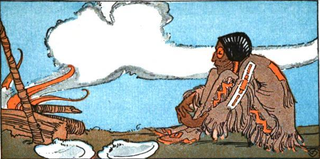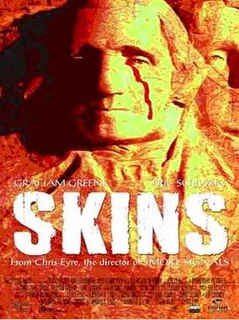Related Research Articles

The Lakota are a Native American tribe. Also known as the Teton Sioux, they are one of the three prominent subcultures of the Sioux people. Their current lands are in North and South Dakota. They speak Lakȟótiyapi—the Lakota language, the westernmost of three closely related languages that belong to the Siouan language family.
Lakota mythology is the body of myths and legends that belong to the Lakota people.

In Lakota mythology, Iktomi is a spider-trickster spirit, and a culture hero for the Lakota people. Alternate names for Iktomi include Ikto, Ictinike, Inktomi, Unktome, and Unktomi. These names are due to the differences in tribal languages, as this spider deity was known throughout many of North America's tribes.
In Lakota mythology, Anúŋg Ité is a daughter of Škáŋ and wife of Tate. She was tricked by Iktomi to attempt to seduce Wi but failed when Škáŋ tells Wi that he has forgotten his wife. For attempting to undo the proper order and place herself in Hanwi's position and forgetting her own family, one of her two faces was made ugly as punishment. She was the mother of the Four Winds and Yum, the whirlwind. Because she was separated from her children, she causes pains to pregnant woman and makes babies cry. She was also said to have taught the Lakota how to separate porcupine quills and dye them.
In Lakota mythology, Unk Cekula is a serpentoid creature which was responsible for many unexplained disappearances and deaths. Her male counterpart is known as Unk Tehi.

Crazy Horse ; was a Lakota war leader of the Oglala band in the 19th century. He took up arms against the United States federal government to fight against encroachment by white American settlers on Native American territory and to preserve the traditional way of life of the Lakota people. His participation in several famous battles of the Black Hills War on the northern Great Plains, among them the Fetterman Fight in 1866 in which he acted as a decoy and the Battle of the Little Bighorn in 1876 in which he led a war party to victory, earned him great respect from both his enemies and his own people.
Bangpūtys is the name of a masculine deity in Lithuanian mythology. Basing on very scanty sources, some mythologists have reconstructed him as a god of sea and storm. According to the reconstructions, he is austere and unrelenting. He has a beard, wings and two faces. He is commonly portrayed as having a fish in his left hand, a utensil in his right hand, and a rooster on the head.
Býleistr is the brother of Loki in Norse mythology.

The heyoka is a kind of sacred clown in the culture of the Sioux of the Great Plains of North America. The heyoka is a contrarian, jester, and satirist, who speaks, moves and reacts in an opposite fashion to the people around them. Only those having visions of the thunder beings of the west, the Wakíŋyaŋ, and who are recognized as such by the community, can take on the ceremonial role of the heyoka.
Joseph M. Marshall III son of Joseph Nelson Marshall Sr. and Hazel Lorraine Two Hawk-Marshall, is a historian, writer, teacher, craftsman, administrator, actor, and public speaker. He was a founding board member in 1971 of Sinte Gleska University, the tribal college at the Rosebud Indian Reservation.

Paul Goble was a British-American writer and illustrator of children's books, especially Native American stories. His book The Girl Who Loved Wild Horses won a Caldecott Medal in 1979.
Iya may refer to:

Skins is a 2002 American feature film by Chris Eyre and based upon the novel of the same name by Adrian C. Louis. The film is set on the fictional Beaver Creek Indian Reservation in South Dakota near the Nebraska border, a place very much like the actual Pine Ridge Indian Reservation, the setting in the book and the place where the film was actually shot. Lakota Sioux tribal police officer Rudy Yellow Lodge struggles to rescue his older, alcoholic brother, Mogie, a former football star who was wounded in combat three times in Vietnam. Winona LaDuke makes a cameo appearance as Rose Two Buffalo.
Dreamkeeper is a 2003 film written by John Fusco and directed by Steve Barron. The main plot of the film is the conflict between a Lakota elder and storyteller named Pete Chasing Horse and his Lakota grandson, Shane Chasing Horse.

Spotted Elk, was a chief of the Miniconjou, Lakota Sioux. He was a son of Miniconjou chief Lone Horn and became a chief upon his father's death. He was a highly renowned chief with skills in war and negotiations. A United States Army soldier, at Fort Bennett, coined the nickname Big Foot – not to be confused with Oglala Big Foot.
Ohunka is a traditional Sioux evening story. They usually feature mythological characters like Iktomi or Iya together with humans. The storyteller's skill required the combination of episodes and keeping the audience interested. Some ohunkakan were collected by Zitkala-Sa in her Old Indian Legends.
Iya Hokshi, also spelled Į'yą hoksi'la, Iya Hoksila or referred to as Stone Boy, is a legend in Sioux mythology.
Wocekiye. The word is sometimes used to denote the practice of contemporary Lakota Spirituality. The Lakota prefer the word spirituality, as opposed to the practice of religion. Central to this spiritual practice is the mythology of Wakȟáŋ Tȟáŋka, or the Great Mystery. Their primary cultural prophet is Ptesáŋwiŋ, White Buffalo Calf Woman, who came as an intermediary between Wakȟáŋ Tȟáŋka and humankind to teach them how to be good relatives by introducing the Seven Sacred Rites and the čhaŋnúŋpa.
References
- Walker, James R. (1983). Elaine Jahner (ed.). Lakota Myth (Reissue ed.). U of Nebraska Press. pp. 428. ISBN 0-8032-9706-8 . Retrieved 2009-03-04.
Iya (mythology).